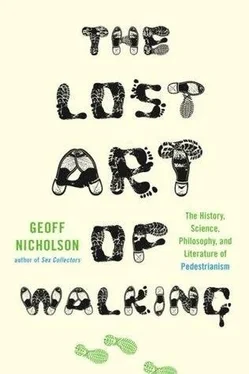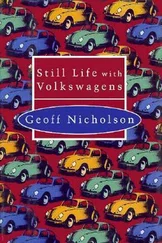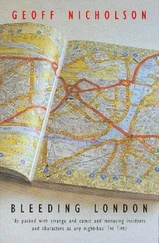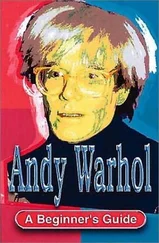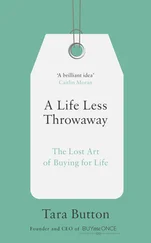When I got to the gallery, just a little before ten, it was closed, and two hassled young women were struggling hopelessly with the lock on the front door. It looked like they had enough on their plates without answering questions from me. There was a café next door where a few would-be psychogeographers were sheltering from the rain and waiting for something to happen. I joined them.
Only very gradually did it become apparent that the start had been delayed, not because of some organizational glitch, but because of sabotage. The gallery wasn’t simply locked, it was sealed. Someone, a disgruntled artist it was assumed, had come along in the night with a caulking gun, glued the gallery door shut, and squirted more of the caulk into the lock. Then, on the concrete in front of the gallery, he (it was surely a he) had painted the sentences ‘Mr. Gorbachev, open this gate! Mr. Gorbachev, tear down this wall!’
The gallery walls were not torn down, but a locksmith duly arrived and opened the door so that the group of us, twenty-five or so by now, who’d gathered in the café were belatedly able to get into the gallery. Eventually some opening remarks were made by Christina Ray, the curator of the festival. This was the fourth Conflux, she said, and over the years the festival’s events had become more technologically based and less ‘analog’. A lot was now happening online, a lot of the psychogeography was now virtual. I found this disappointing. There are few activities more analog than walking. And she said that whereas in previous years Conflux had often featured maps to help you find your way around, this year there would be maps to help you get lost.
I looked out the window and saw that in front of the gallery, in the rain, there was a young woman sweeping the street. This, I knew, was a walking art project entitled ‘Sweeping (Sidewalk Performances #1)’ by an artist named D. Jean Hester. By her own account, ‘I will sweep the sidewalks near the gallery. Based on a daily activity of shop owners and residents in my urban LA neighborhood, sweeping the public sidewalk is an expression of pride in one’s place, as well as a gift given to others who use the area. While sweeping and engaged in a ‘helpful’ activity for the neighborhood, I may greet people who pass by with a ‘Good morning!’ Will the activity of sweeping make me more approachable, allowing people to interact with me in a less guarded fashion?’
I didn’t have an absolute answer for her question. True, I did approach her, but the interaction was guarded on both sides. By the time I got out to the street she’d stopped sweeping. She’d been at it for all of ten minutes, and that was another disappointment. I’d imagined she’d be sweeping throughout the festival, for the whole four days, for a hundred hours or so of continuous endurance sweeping and walking. I liked the sound of that. But no.
She told me it was really hard to sweep in the rain, what with holding her umbrella and all. I asked her how large an area she was planning to cover, and she said that given the rain, she was just going to do the small stretch in front of the gallery, but maybe when the rain stopped she’d do the whole block. Again, I had been overambitious on her behalf. I’d thought she might try to sweep the whole zip code.
Then I asked whether she was sweeping the road as well as the sidewalk, since I could see there was a lot of garbage lying there in the street. No, she said, just the sidewalk. We agreed it was good to set yourself limits.
The first event in the gallery was a ‘discussion session’ with an artist named Sue Huang, about her ongoing project ‘Street Cut Ups’. It involved walking the streets of wherever she happened to be, looking for bits of text on signs, posters, ads, and so on, which she would cut out, take away, and then stick together to reveal other, more subversive meanings. It came as no surprise that she claimed to be influenced by the ‘cut up’ method, and by the ‘literary play’ of Oulipo. It was more surprising, and disappointing, that her press release referred to someone by the name of William S. Borroughs ( sic ).
The discussion session consisted of the artist sitting at a table in the gallery with a laptop in front of her, like a nervous vendor at a trade show, as people milled around her, and occasionally someone would stop and ask, metaphorically at least, ‘What are you selling?’ Again I had unreasonable expectations. I’d thought the artist might lead a tour, and we’d walk through the streets of Brooklyn, slashing at posters, snatching words, liberating them, performing a specialized form of anti-logorrhea, sucking words in rather than squirting them out. But we looked out through the window at the rain, and it became all too clear that nobody was going anywhere. Except me. This session was due to last an hour to be followed by a session with a different artist, which I suspected might be all too similar. I couldn’t face that. I left the gallery, went back to Manhattan, and kept my powder dry.
♦
The next day I was signed up for something called ‘Public Parking’, a walking tour of certain Brooklyn parking lots, organized by the Temporary Travel Office, the brainchild of one Ryan Griffis.
I’m a big fan of walking in parking lots, partly because it’s simply a perverse thing to do, but also because it’s a small act of reclamation and defiance. Taking a walk, even just a shortcut, through a parking lot is a way of saying that this open space, and sometimes it can be the only open space for miles around, isn’t the sole province of cars and drivers. And if there’s a chance of being run down by cars maneuvering into or out of parking bays, then so be it.
I felt there had to be some ironies in a walking tour of parking lots, but I wasn’t sure that the Temporary Travel Office’s ironic fault line was in the same place as my own. Certainly the professed purpose of the walk was po-faced enough, which didn’t mean that it was easy to take it entirely seriously.
‘Public Parking’, said the Temporary Tourist Office, ‘is an investigation into the realities of Utopian thought as materialized in the mundane and pragmatic spaces of parking lots. Parking lots, one of the most visible, yet overlooked, artifacts of American mobility reveal the concrete space required to store the supposed tools of Utopian ideals’. There was quite a bit more of this stuff, including a reference to ‘participatory mapping of personal Utopias upon the topography of property development’. I tried to remain optimistic.
The tour started at four in the afternoon. It was still raining hard. A dozen or so of us packed into the Temporary Travel Office’s rented van, dripping and steaming, and for forty-five minutes Ryan Griffis, a pleasant, friendly, nervous, enthusiastic man, drove us through Friday afternoon rush-hour traffic, heading eastward for the first of the parking lots.
As we drove through a Brooklyn of factories, workshops, warehouses, and self-storage units, we heard a recorded commentary, interspersed with music, telling us facts and figures about parking. This was perfectly unironic as far as I could tell, and it sounded like urban studies research rather than art, but this suited many of the people in the van, since it appeared there were some genuine parking lot scholars and enthusiasts onboard.
The traffic was impenetrable, the drive was slow, and the recorded commentary had ended long before we arrived at the first lot. This was the Grant Avenue Municipal Parking Lot adjacent to the Grant Avenue subway stop on the A line in deepest eastern Brooklyn. It had been chosen precisely because it was so far from anywhere.
It was a nice enough parking lot in its way, spacious, not full, a place you could leave your car without fearing it would be stolen or stripped down, and it had a surface that was smoother and better maintained than anything we’d driven over on the way there. There were signs telling you how to park: at 90 degrees to the retaining wall, and inside the parking bay, and to reverse into the spot so that leaving was made easier. Our van pulled in and parked.
Читать дальше
